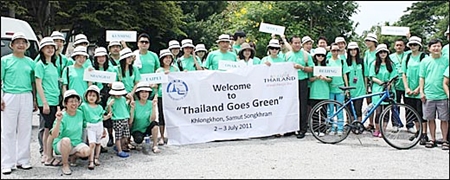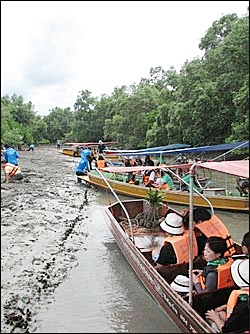Bangkok, July 21, 2011 — The Tourism Authority of Thailand (TAT) has taken a major step forward in its “Thailand Goes Green” campaign by highlighting some of the environmental spots of Samut Songkhram province, just a short drive away from Bangkok.
The TAT East Asia region flew in a group of 56 media and travel agents from China, Japan, Korea, Hong Kong and Taiwan to visit Khlong Khon district in Samut Songkhram Province. The group participated in cycling tours, experienced the local lifestyle and nature attractions of the Bang Khon Thi community-based tourism project, visited Rim Klong Floating market and left their mark by planting mangrove trees together.

The highlight of the tour was a visit to Amphawa Water-based Community, which was awarded an “Honourable Mention” in the 2008 UNESCO Asia-Pacific Heritage Awards for Culture Heritage Conservation.
According to the UNESCO website, “Historically speaking, the (Amphawa) area has been well established as a water-based settlement and trading area dating back as far as the late Ayutthaya period in the mid 17th century. It is also significant for its royal and religious associations as two Thai kings once resided within the Amphawa District, and a translation of its name means a “Mango Grove”, which denotes a location associated with the Lord Buddha’s life.”
From a policy perspective, the visit was in line with the TAT’s desire to decongest visitor arrivals from Bangkok by promoting surrounding destinations, introducing new products to broaden the packaging opportunities and motivating the industry to maintain a strong focus on preserving the environment in all aspects of future tourism.
Located 72 kilometres from Bangkok, the province of Samut Songkhram lies right on the highway between Bangkok and the popular West Coast beach resorts of Hua Hin and Cha-am. If tours can include some of these new spots in their itineraries, it could extend the visitor length of stay in Thailand by at least one day. The province is also well-known for its salt-farms.
According to Mrs Jamnong Junnapiya, Executive Director, East Asia Region, TAT said “This is the first time we have organised ‘Thailand Goes Green’ activities as part of a pilot project to raise environmental awareness amongst visitors from the East Asian region.
“By promoting opportunities for visitors to combine a leisure holiday with stops to experience Thai culture and interact with the local communities, we are trying to ensure that Thailand retains its long-standing reputation as a ‘value-for-money’ destination.”

She said that the strategy encompassed the five key pillars of tourism today: Ecotourism, community-based tourism, creative tourism, sustainable tourism and modern marketing methods.
Mr Amnuay Thiamkeerakul, Director of the TAT’s East Asian market, added, “We took special care to invite 24 media representatives from the primary Chinese cities of Beijing, Shanghai, Kunming and Guangdong as part of the policy to upgrade the quality of package tours in the Chinese market.
“Thai Airways International and a number of Chinese airlines are flying directly to Bangkok from all these four cities, and tour operators there are now looking for new products to offer to an increasingly sophisticated Chinese traveller.”
The visit was well-received among all the invited participants. Mr Ruan Renshu of Outdoor Magazine (China) said he had enjoyed the mangrove-planting experience and looked forward to seeing the results. Ms Rosanne of Nationtainment Corporation (China) called the experience “unforgettable.” Mr Wilson Poon of Hong Kong Wing on Travel Service Limited said the tour would definitely win favour among Hong Kong residents.
Ms Yumiko Mochizuki of Travel Journal (Japan) said most of the Japanese visitors tend to flock to the traditional spots of Bangkok, Phuket and Chiang Mai, but Samut Songkhram would clearly provide them with opportunities to diversify into other destinations with interesting new experiences.
Ms Lin Cha Yen of Travel Rich magazine (Taiwan) said that in the past 2-3 years, cycling had become very popular in Taiwan. Visitors from there would enjoy indulging their passion during a tour of Thailand, too.
In 2010, international visitor arrivals to Thailand totalled 15,936,400, up 12.63% over 2009. Of these 3,635,345 visitors were from the East Asian region (20% of the total market share).
The top 5 markets from East Asia during January – May 2011 were China (793,266 +68.17%), Japan (573,271 +20.57%), Korea (517,725 +35.37%), Hong Kong (206,935 +58.94%) and Taiwan (252,170 +26.80%).




